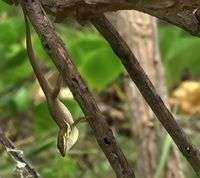How to stand out, lizard-style

(PhysOrg.com) -- If you've ever tried waving to someone distant in a bustling crowd, you'll have some idea of how hard it can be for small rainforest animals to signal to each other with so many other distractions to catch the eye.
That's the formidable challenge facing Caribbean Anolis lizards: they live amid tropical vegetation where wind creates a blur of almost constant motion, yet they rely on subtle body movements to attract mates and warn off rivals, notes a new study.
Writing in the journal The American Naturalist, a team of researchers led by Dr. Terry Ord of the UNSW Evolution and Ecology Research Centre report how they studied eight lizard species on the islands of Jamaica and Puerto Rico and found that each species had evolved its own way to stand out from the surrounding visual "noise".
Male Anolis lizards strut their physical stuff in workouts involving a rich variety of elaborate head-bobbing movements, for example, and can perform push-ups or puff out a dewlap - a colored throat pouch - to advertise their ownership of a territory, says Dr. Ord, who specializes in the evolution of social behavior and animal communication.
He says that by varying the speed, duration and size of these movements in response to its own environments, each Anolis species has developed its own signalling "language" and it appears that even regional "dialects" have emerged as well.
"It's quite striking how different these lizards on these islands handle so much visual environmental noise," says Dr. Ord. "Low light levels within the forest only make the job of being seen more difficult.
"We have all experienced the difficulty of trying to communicate with one another in noisy situations, whether it’s at a raucous party or out on the street as a loud truck goes by. In these situations, we tend to change the way we talk to compensate for the increase in background noise, such as talking louder or repeating ourselves to be sure the other person had heard our message properly. That's in effect what these lizards are doing.
"In earlier studies we showed that one way they seem to compensate for visual noise and poor lighting is to speed up – exaggerate – their body movements. We built a realistic robot Anolis lizard and programmed it to perform different display sequences that varied in speed and recorded how long it took a real lizard to see the displaying robot in its territory. High-speed display movements made the difference, especially in dark areas of the forest.
In the latest study, the team found that the type of strategy lizards used to maintain a conspicuous display was heavily dependent on island origin. Puerto Rican lizards maximized detection by performing territorial displays at times when visual noise in the environment was low. Jamaican species, on the other hand, used a display that includes rapid extensions of the dewlap, which is effective at attracting the attention of territorial neighbors in a range of environmental conditions.
"The study provides a rare example of how different evolutionary starting points can lead to different evolutionary outcomes," says Dr. Ord. "It just goes to show that we can't necessarily predict what evolution will come up with, even when we know what the specific selective pressures at work might be."
Provided by University of New South Wales

















